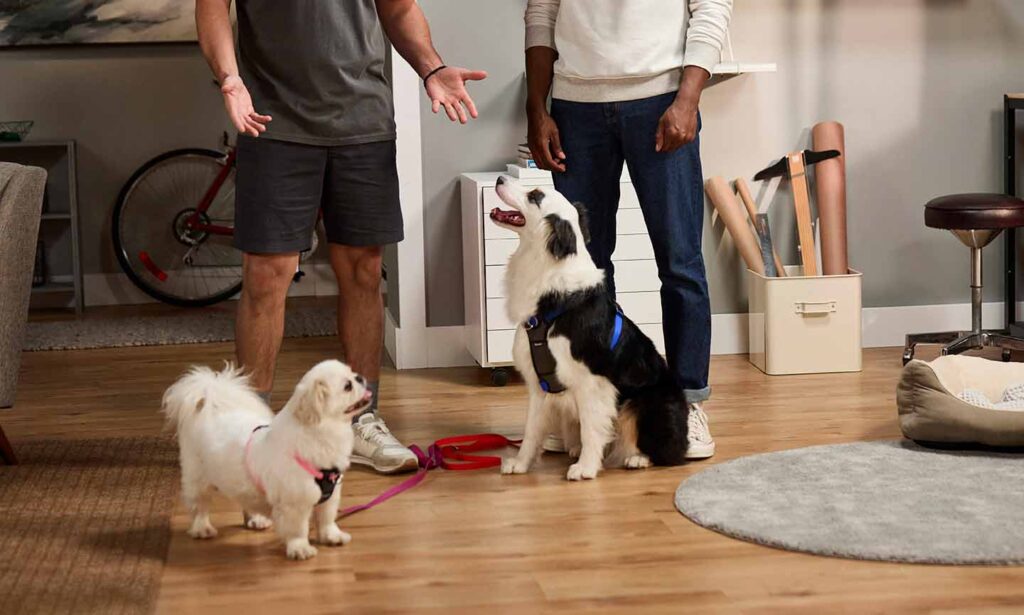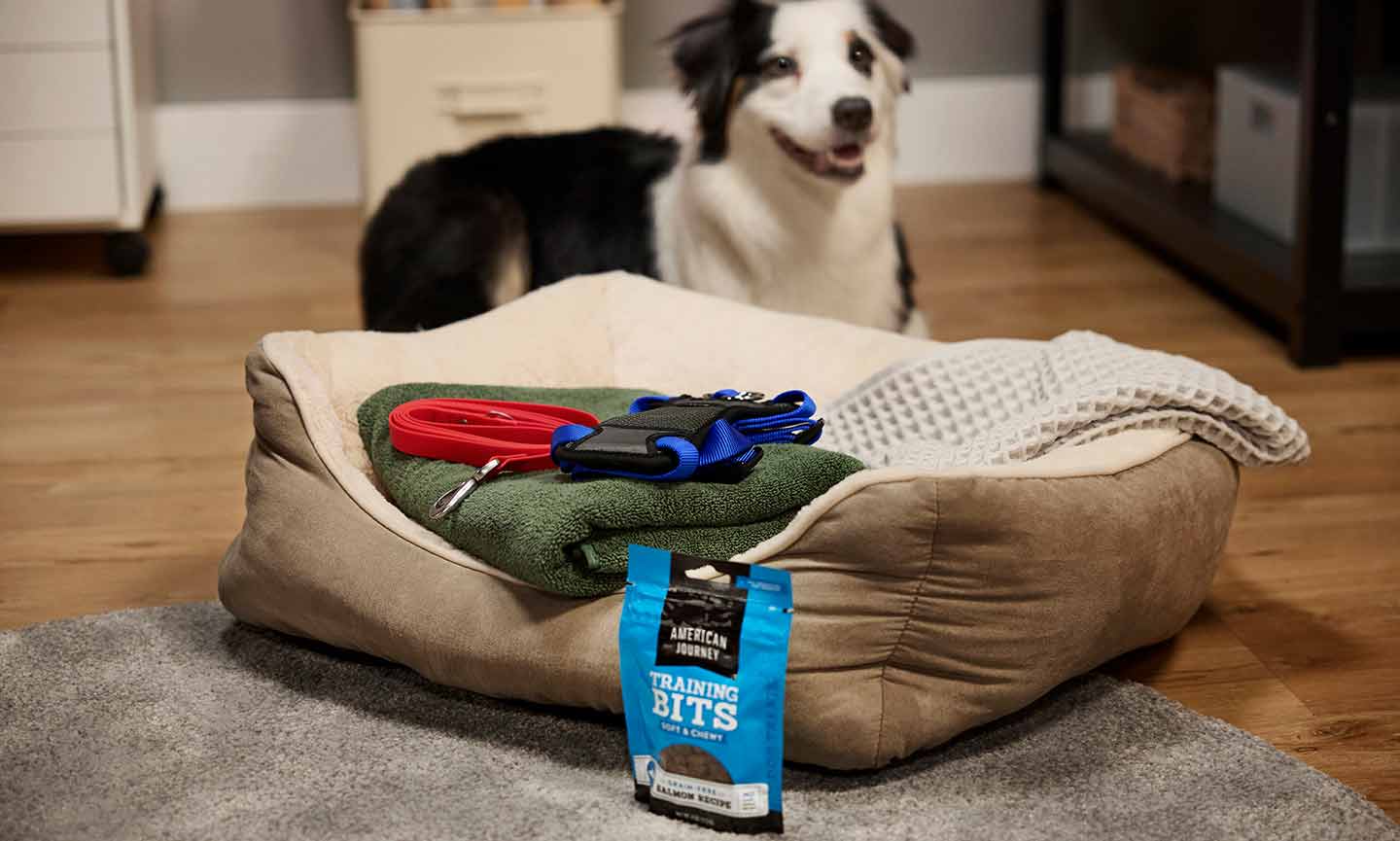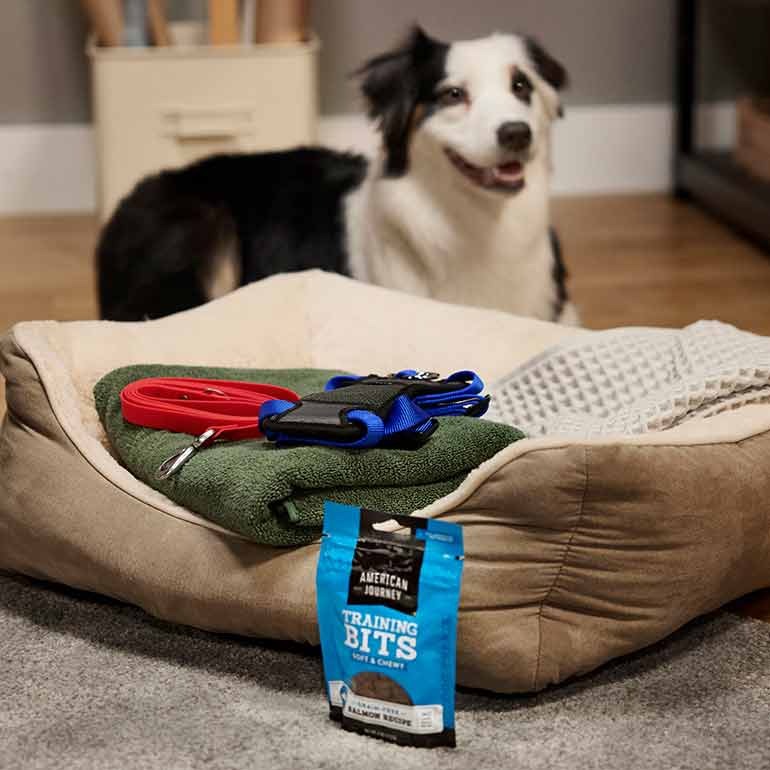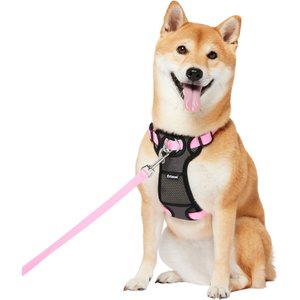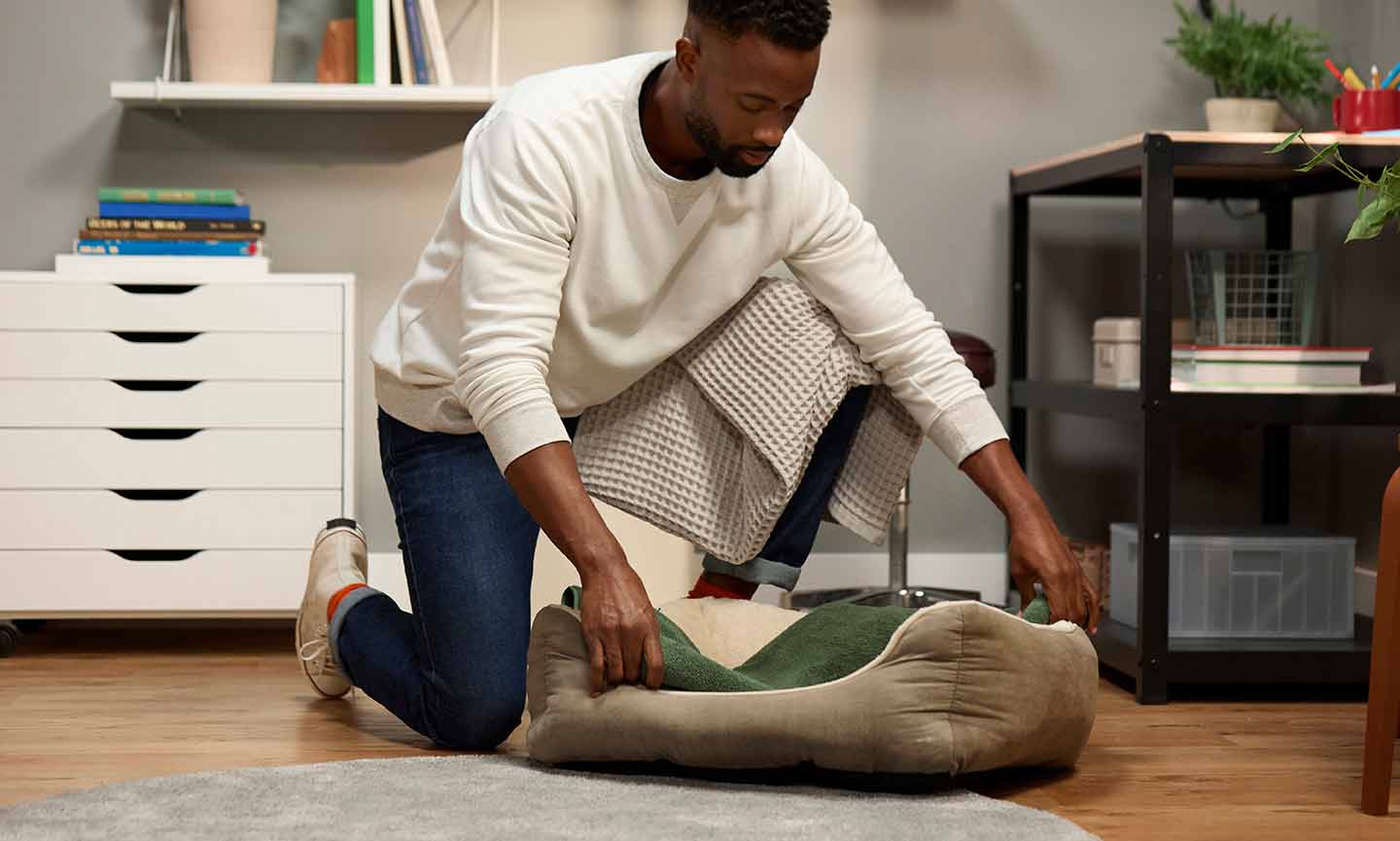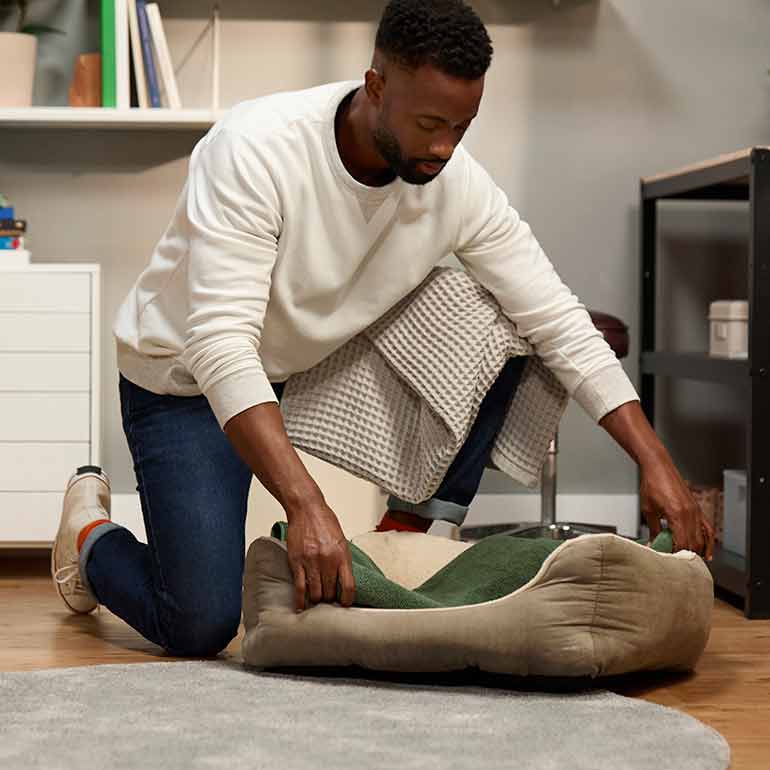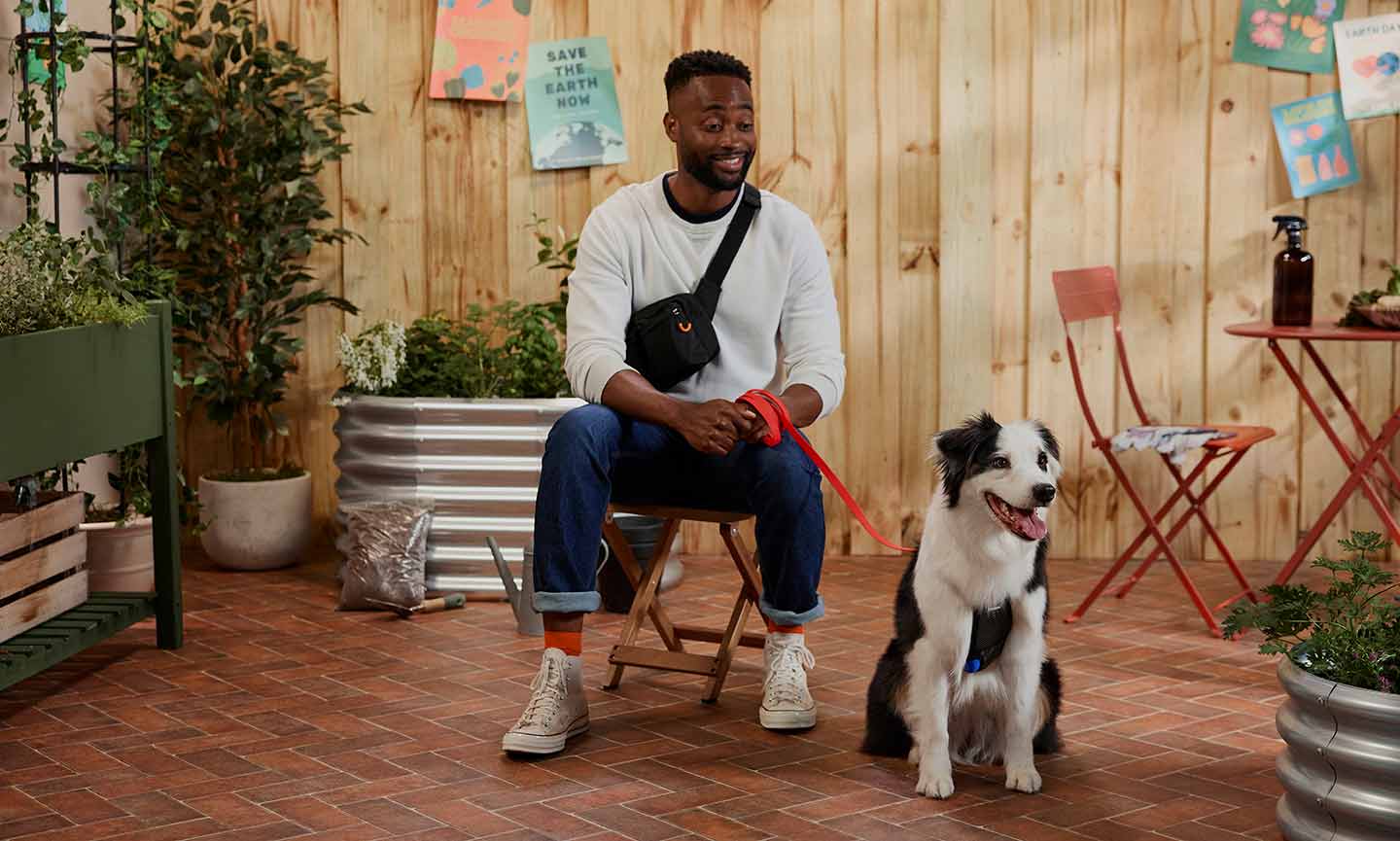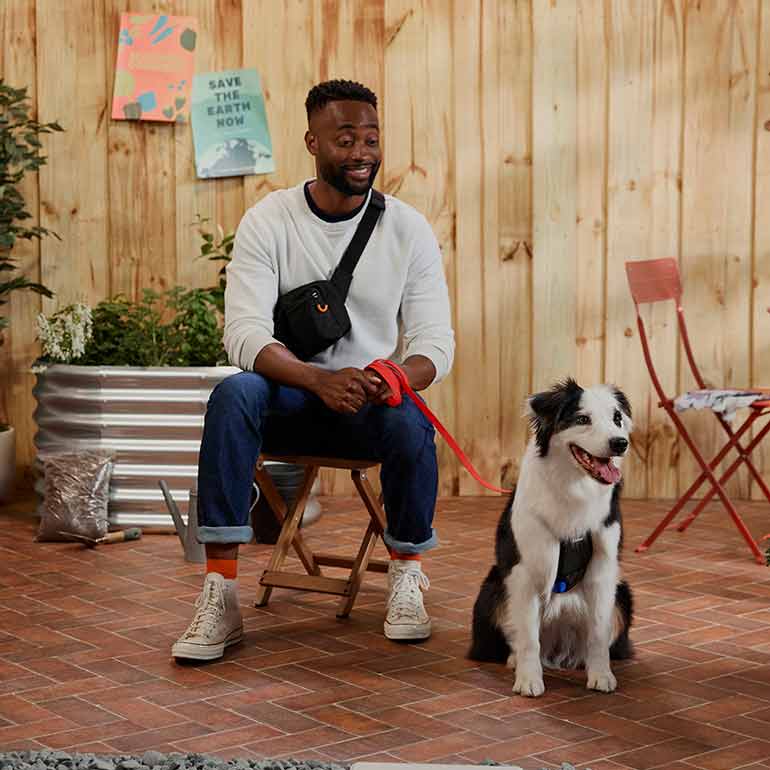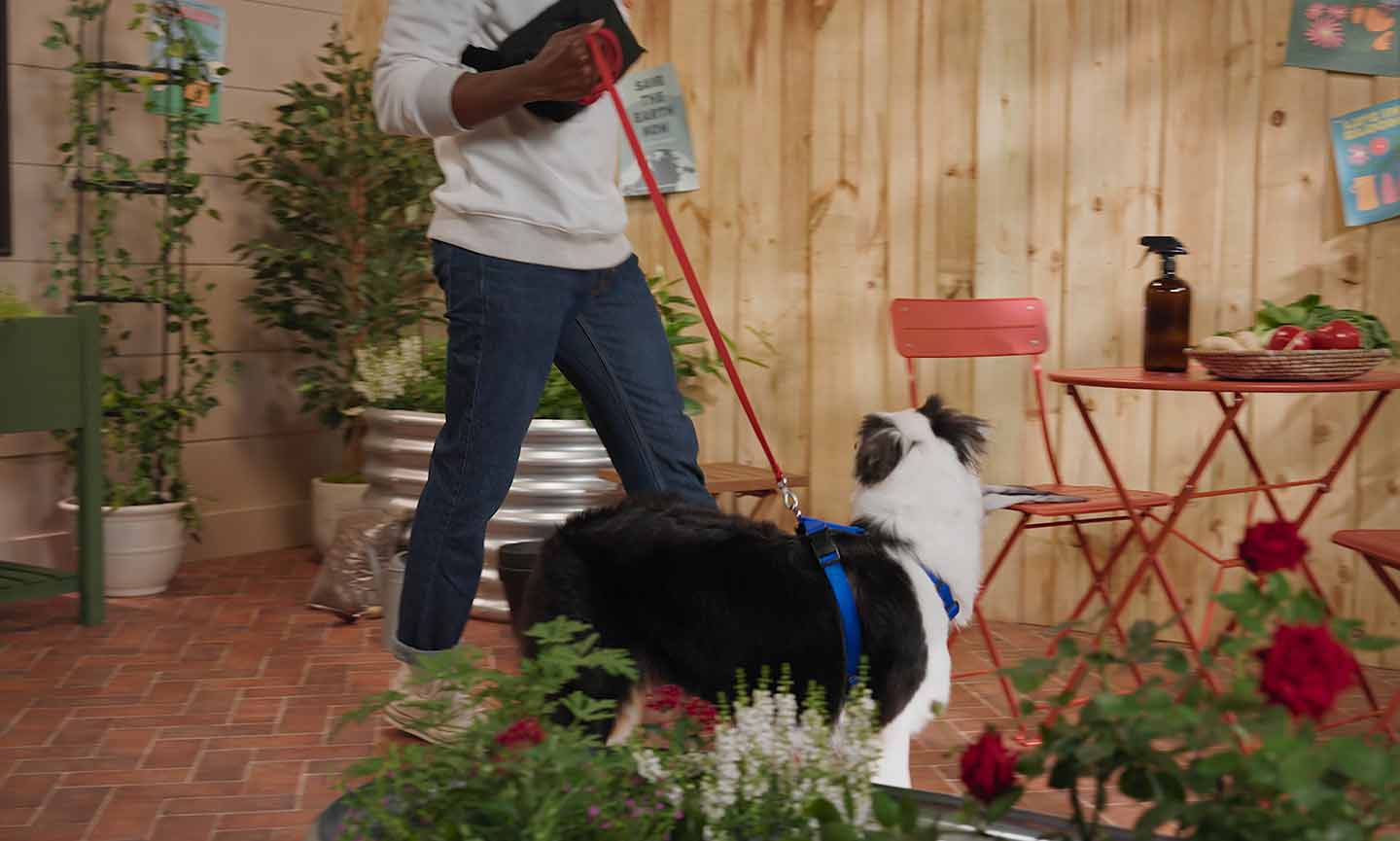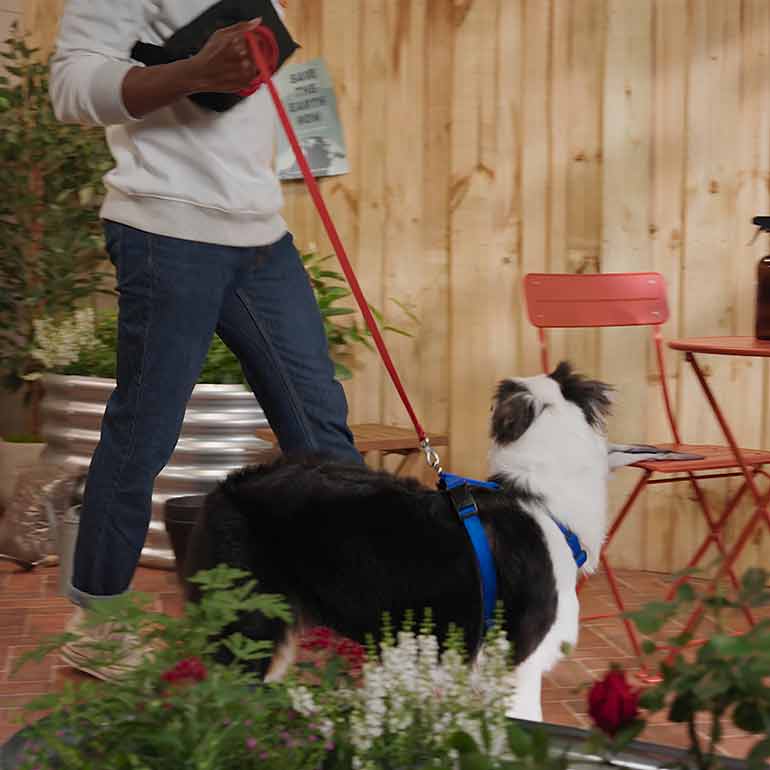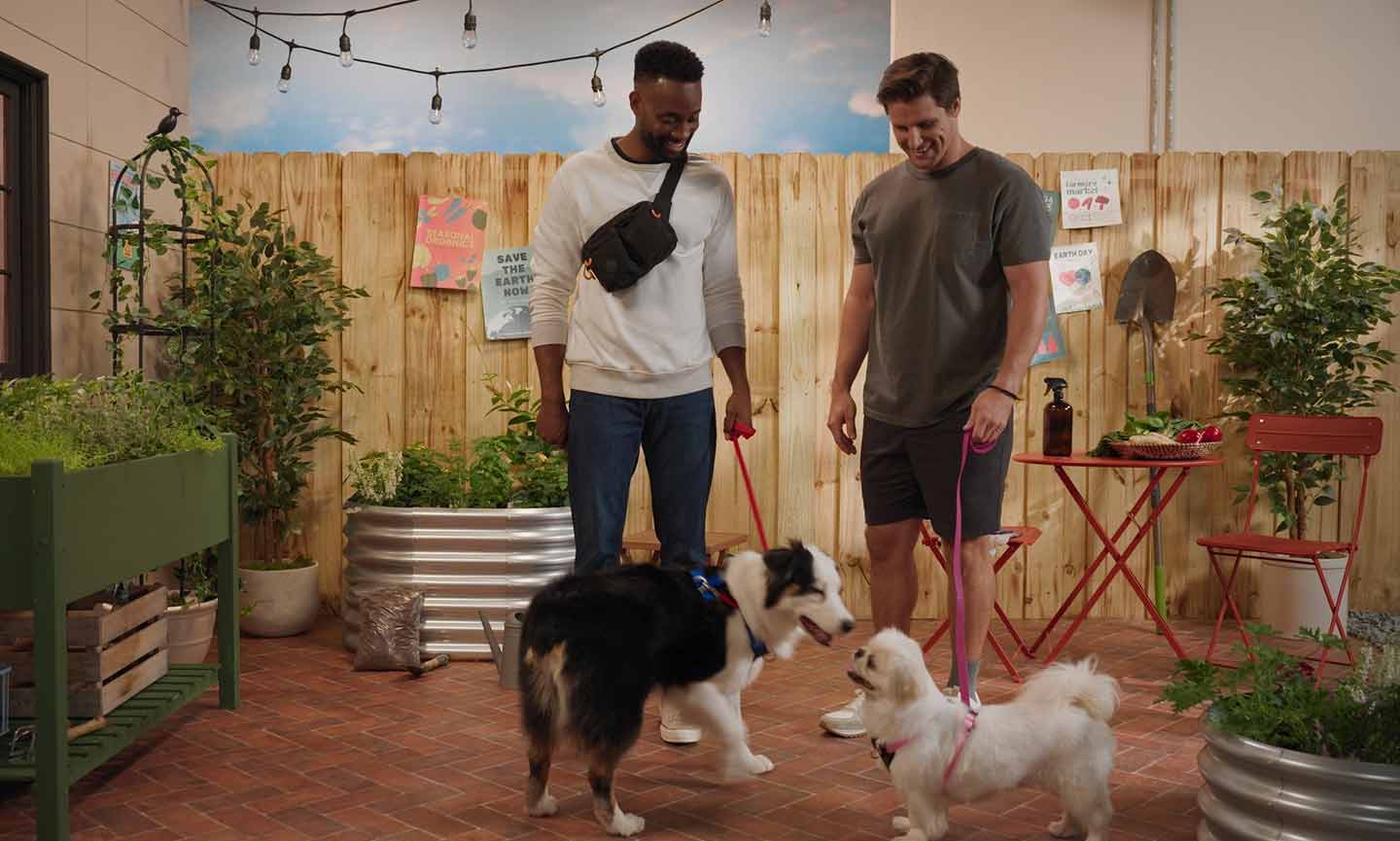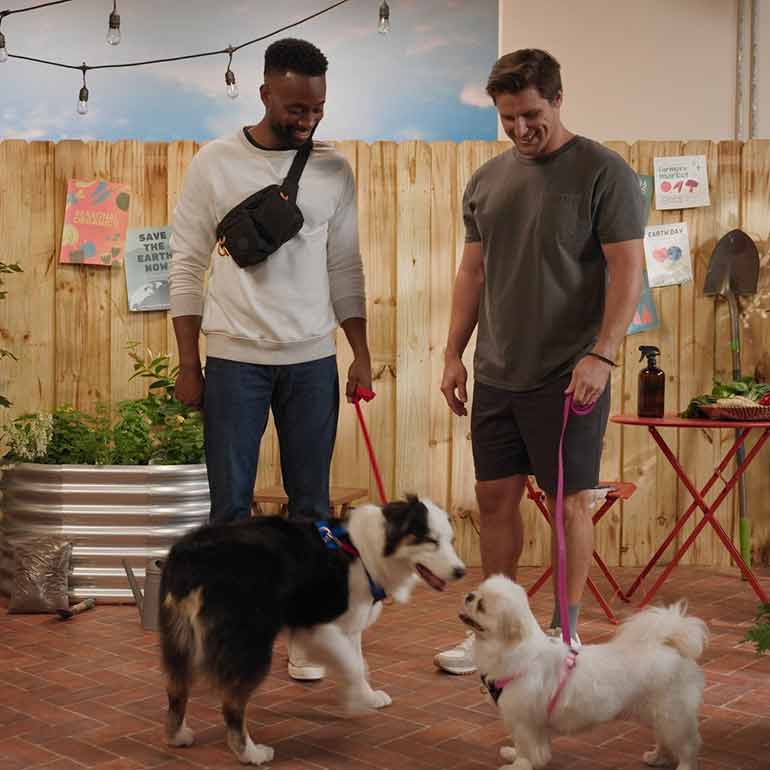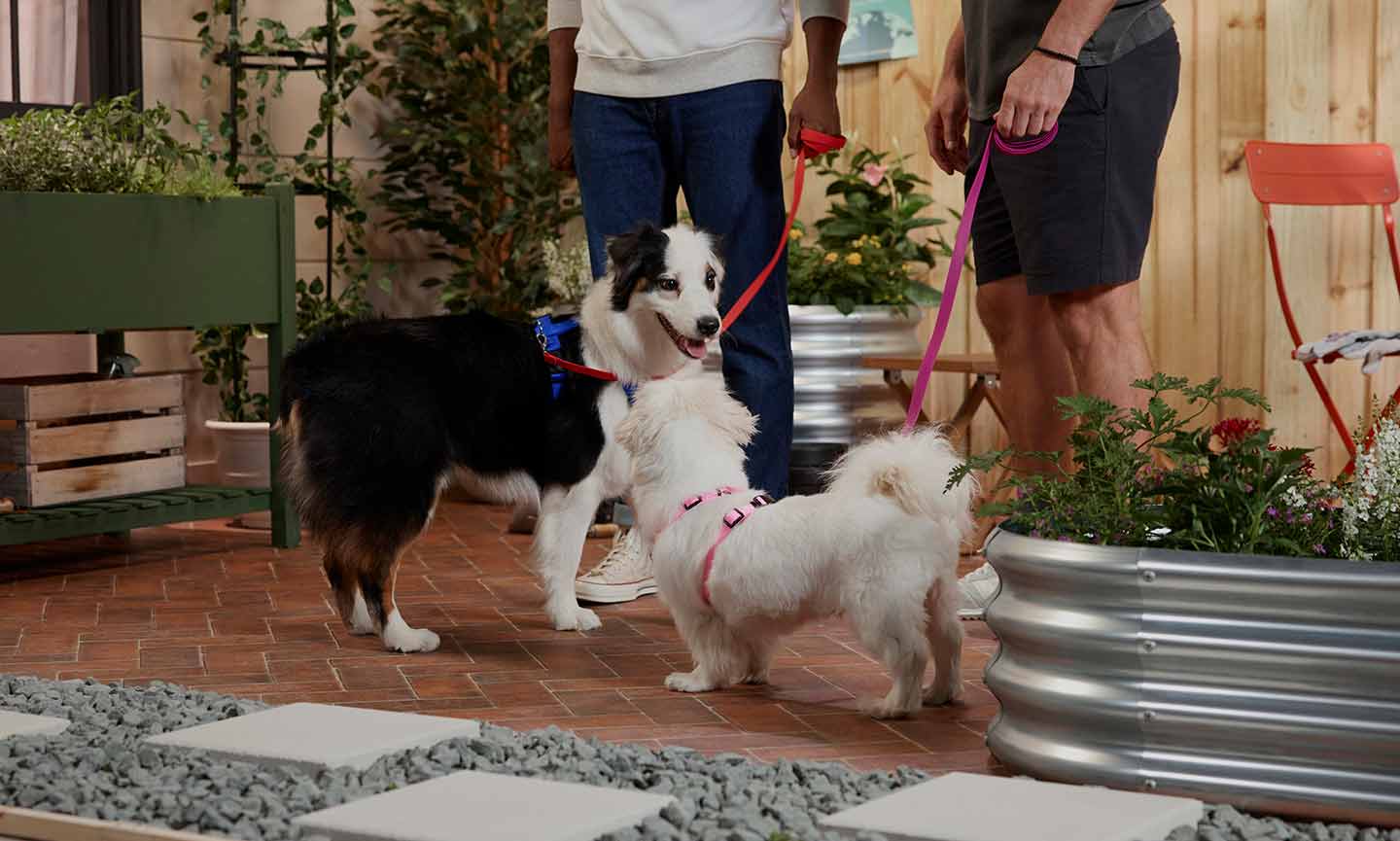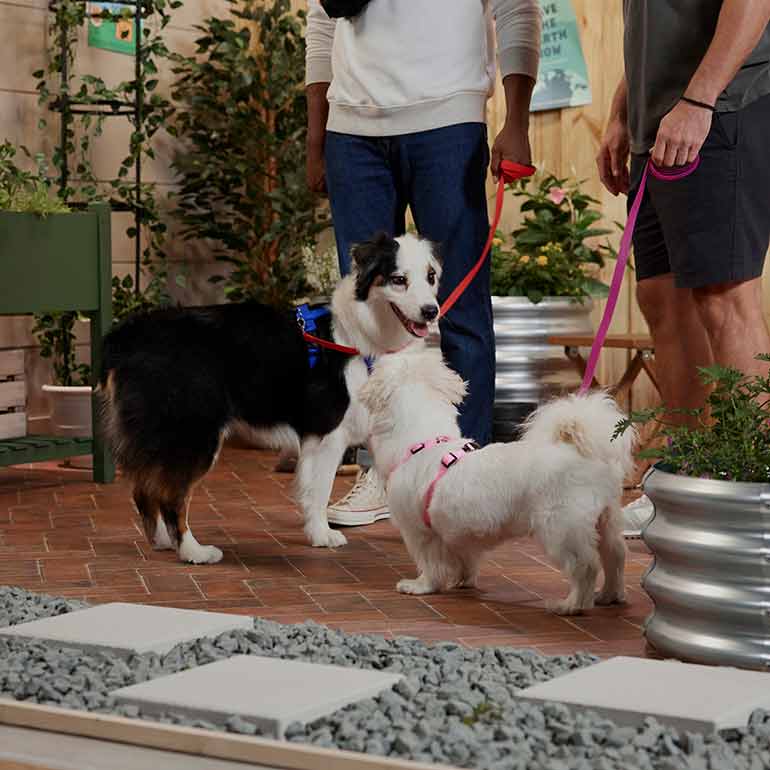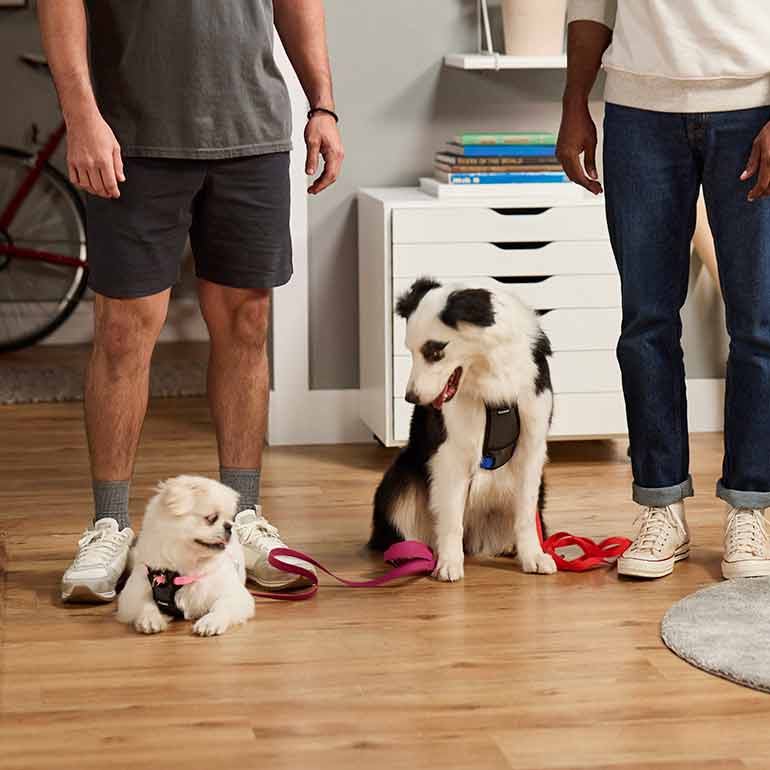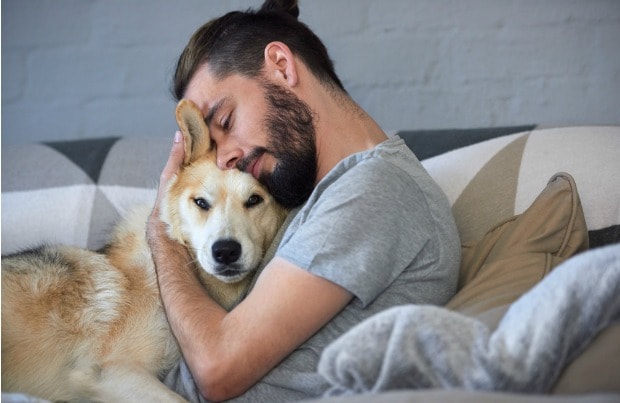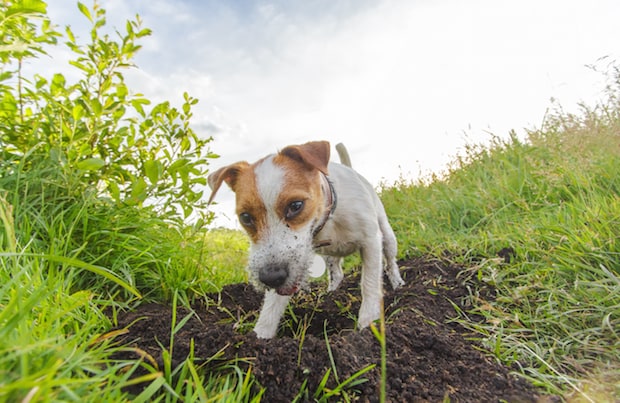Thinking about getting a second dog, or setting your dog up on playdates? For many dogs, that’s a great idea. Dogs are social animals, and hanging out with fellow pups can be a lot of fun for them—if they’re introduced properly and are the right fit. Highly sociable dogs may be able to shake off a rocky intro, but if a dog is shy or only likes certain types of other dogs, they may have a tough time getting over a bad first impression. So how can you set your pup up for success? We’re walking you through the best way to introduce dogs.
In This Guide
How to Introduce Dogs: Step-by-Step Instructions
Follow this guide to help the dogs make a good first impression and increase the odds that they’ll become best friends.
1Gather Your Supplies
You’ll need:
- At least two people/pet parents (one for each dog)
- A properly fitting harness or collar for each dog
- A leash for each dog
- Dog treats, cut up very tiny
- A neutral place for a walk, with plenty of stuff to sniff and explore
- A fenced-in yard in neutral territory (optional)
- Towels for the dogs to lie on (optional)
”Neutral” means the area is new to both dogs (or at least not a place either dog knows well).
2Do a Towel Exchange (Optional)
Dogs are very focused on smells, and the smell of another dog can seem strange or even threatening to them. For that reason, letting dogs get used to each other’s smells in advance can make an introduction go much more smoothly. A towel exchange is a great way to make that happen.
Start by putting towels in the beds of each of the dogs you are planning to introduce. When the dogs lie down in their bed, their scent will transfer onto the towel. After a night or two of sleeping with the towels, switch them, so that each dog is lying on the other dog’s towels.
Continue to switch the same towels back and forth (without washing them) so that the dogs’ smells combine on the towels. Do this for a few days before you do your first introduction.
This step isn’t possible for every new dog introduction, of course—but it’s a great way to start if you can.
3Meet in a Neutral Area
Dog introductions are more likely to go well when the dogs meet each other on a walk in a neutral territory with plenty of distractions (aka stuff to sniff and explore). That’s because:
- Dogs can behave territorially in areas they are very familiar with.
- Walks in “sniffy” areas give the dogs something to think about other than each other.
So for the dogs’ first meeting, choose an area that neither dog has seen before, and that has lots of bushes, grass and other enticements. A calm street in a new neighborhood with plenty of green space would be a perfect pick to encourage good dog behavior.
You’ll use this neutral area in steps 4 and 5 below. In step 6, you’ll take the dogs to a home or fenced-in yard. For convenience, you may want the neutral area in steps 4 and 5 to be within walking distance of the fenced-in yard in step 6—that way you can walk over to it with the dogs if they’re getting along.
4Take the Dogs for a Long Walk
Once you’ve picked a neutral area, set a time to begin—but don’t bring the dogs close to each other just yet. Instead, start on opposite sides of the street, and begin walking both dogs on leashes in the same direction, so they’re staying roughly parallel to each other. Feed treats to the dogs whenever they look at the other dog. This helps keep them calm and teaches them that the other dog is a good thing!
Walk this way until both dogs are more interested in treats than each other. When that happens, allow one dog to move ahead about 20 feet. of the other dog, then cross the street so both dogs are on the same side of the road. Continue walking and feeding treats when the pups look at each other. Remember to maintain that 20 foot distance—so if the dog in front stops, the handler in back should stop, too.
When both dogs can walk calmly, turn around and start walking the other way, so that the dog in front is now in back, and vice versa. When the dogs are able to remain calm, you’re ready for the next phase.
5Allow the Dogs Some Brief Rear-End Sniffs
Dogs staying calm at a distance? It’s time to let them get closer—but only for a moment. Let the dog in back catch up to the dog in front and allow them to sniff the other dog’s rear end.While the dog in back is sniffing, the handler in front should feed treats to the pup who’s being sniffed—that’s to help keep them calm and cool while they’re being checked out.
After about 3 seconds, coax them away. (It’s OK to use a treat to do so.)
Next, change directions and let the other dog do the sniffing while the “sniffee” enjoys a steady stream of treats.
We know what you’re thinking: “Am I really encouraging my dog to sniff butts right now?” Well, yeah. It might seem funny, but sniffing each others’ behinds is part of how dogs get to know each other. Repeat this process three times, keeping the sniff sessions short, about 3 seconds each. If either dog’s body language communicates anxiety or discomfort during this process, go back to the previous step. Cues that something is amiss may include:
- Cowering/hanging their head
- Staring directly at the other dog
- Flattened ears
- Fur sticking up/standing on end
6Let the Dogs Greet Each Other
Now that the dogs can calmly follow each other and have gotten a couple of quick sniffs in, it’s time for an exercise I call a “flyby.” It goes like this:
- Move the dogs about 15 feet apart and let them face each other.
- Take a moment to evaluate the dogs: Do they look relaxed or maybe even a little bored about each other? If not, go back to the previous step.
- If the dogs are relaxed, each handler should hold the leashes so that they stay very loose and take a few more steps toward each other. Feed each dog treats for the first few steps, to help keep them from rushing toward the other dog.
- When the dogs get close enough to touch and are still remaining calm, allow them to greet each other for about 3 seconds, and then continue walking past each other. You may need to use a treat to lure the dogs apart.
The looseness of the leash is crucial here—tight leashes often lead to fights, so be sure each dog is walking beside their handler with the leash hanging in a U-shape between the two. If the leash is pulled straight, step forward to loosen the tension, and if your dog keeps pulling forward, go back to the previous step. (This might also be a good indicator that it’s time to brush up on leash training.)
Repeat these flybys three times, ensuring the dogs remain calm throughout. If everyone’s staying relaxed, practice walking with both handlers next to each other, so the dogs are walking in the same direction. Each handler can continue to feed their dog treats as the dogs walk together, but the dogs may find it more interesting to sniff and pee on whatever the other dog sniffed and peed on.
If at any point either dog shows signs of stress, such as a stiff body or pulling on the leash, go back to the previous step.
7Relocate to a Home or Fenced Yard, Then Drop Their Leashes
This next step takes place in a home or fenced-in yard, aka somewhere with a boundary that’ll keep the dogs from running away. It’s ideal, but not necessary, if this is neutral territory, too, so consider asking a friend or family member if you can borrow their space. No luck? No problem—you can use a home or yard that “belongs” to one of the dogs, too.
Whatever you choose, as we recommended above, it’s convenient if the new location is within walking distance of the neutral territory you and the dogs used in steps 4 and 5. The bigger the space, the better, and make sure all toys, food bowls and water dishes are removed, to prevent resource guarding.
When you arrive at the new location, follow these instructions:
- Have one handler wait about 15 feet from the entrance. Allow the other handler to walk their dog in first, moving as far from the entrance as possible and feeding treats along the way. If you’re using one of the dogs’ homes or yards, allow the “guest” dog to walk in first.
- When the first dog is in position at the far end of the space, the second handler can walk their dog in, stopping just inside the entrance, also feeding treats.
- Walk the dogs around, feeding treats and allowing them to sniff, until the dogs are more focused on their handlers or interesting smells than each other.
- Repeat steps 4 and 5, having the dogs follow each other, allowing brief rear-end sniffs, and a couple of flybys. Ensure the dogs are consistently relaxed.
If all of that goes well, drop the dogs’ leashes and let them drag on the ground as the dogs wander around and/or greet each other as they please.
- If the dogs do greet, allow them to interact for about 30 seconds before calling them apart and feeding them a treat. Then allow them to go back to wandering and/or greeting.
- If you notice any tension, call the dogs to you immediately, using the leashes to gently pull them apart if necessary.
If the dogs stay calm, you can gradually start extending the amount of time they interact, working up to a 10 or 15 minute hangout sesh.
Dogs still calm? Congrats! You’ve completed a successful introduction. It’s important to continue to practice the above steps until there are no signs of stress, fear or aggression in each others’ presence, but you’ve laid the groundwork for a solid friendship between the pups.
If this is just a visit, you can stop there. The next time you visit, follow the same steps as before:
- Start with a short walk together to make sure they can still relax around each other.
- If that goes well, walk them into the house (always having the guest dog enter first).
- Inside, do some on-leash following, sniffing and flybys.
Keep practicing the above steps until the dogs routinely show no signs of stress, fear or aggression in each others’ presence. For some dogs this process can be as quick as a day or two. For others, it can last weeks or even months. Remember that every dog gets comfortable at their own pace, and that rushing them can backfire and cause them to take even longer to accept their new friend.
Adding a New Dog to Your Home
It’s one thing to have a dog visit as a guest; it’s another to have them move in. If you’re adding a new pup to your family, it will take both dogs time to adapt to being in a household with each other. To ease the transition of bringing home a new pup, follow steps 1 through 6 above—then continue the process with these tips:
- Keep the dogs in separate rooms most of the time for a few days, and only have them together when you are supervising.
- When the dogs are together, make sure there are no toys, food or other valuable items to fight over.
- After the first introduction, take the resident dog on a walk and allow the new dog to explore the home at their own pace. You can then do the opposite: Take the new dog on a walk and let the resident dog explore the home now that the new dog’s smell has been added to it.
- Separate the dogs with a barrier like a dog gate or closed door during feeding time to avoid conflicts over meals.
- Keep the dogs’ interaction sessions short (no more than 15 minutes) for the first week. Have them drag leashes during these sessions, just in case it’s necessary to pull them apart.
- If all goes well after about a week, you can start taking off the leashes and letting the dogs spend more time together.
- For safety, separate the dogs whenever you are away from home for at least the first few weeks.
What if They’re Still Not Getting Along?
So, you tried the steps above but one or both dogs were so tense that you couldn’t complete the process—now what? It’s time to consult a certified professional. You’ll need an expert who has received education on how to deal with challenging behavior. Look for a certified behavior consultant near you in listings provided by the Certification Council of Professional Dog Trainers or the International Association of Animal Behavior Consultants.
A certified behavior consultant can help you use force-free methods to improve the relationship between two dogs. They will also be able to let you know if the dogs aren’t the right fit for some reason. This does happen sometimes—for example, when one dog is much bigger, younger, and more energetic than the other dog. Don’t feel embarrassed if this happens in your household. Just like people, some dogs get along better than others.
Choosing the Best Play Partner for Your Pup
When choosing social partners for your dog, consider these factors:
- Size: Are the dogs around the same size, or is one at risk of being trampled by the other?
- Age: Are the dogs close in age, or is one significantly older or younger?
- Play style: Do the dogs like to play the same way (i.e. both love running/chasing, or pulling on tug toys)
- Energy level: Are the dogs’ intensity of play similar? Or does one have tons of energy while the other is more chilled-out?
While there are plenty of “odd couple” dog besties—a senior dog who’s bonded to a puppy, or a Chihuahua who can’t live without their Great Dane buddy—in general, it helps if your dogs are similar when it comes to these factors. After all, if one dog wants to play 24-7 but the other just wants to nap, neither dog will be very happy! It’s a lot easier for dogs who are equally enthusiastic about play to make friends.
More New Pet Introductions
Share:
